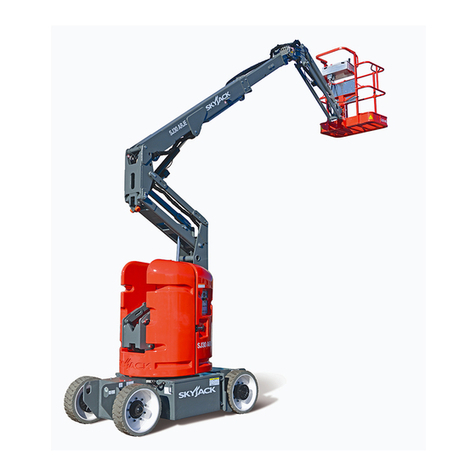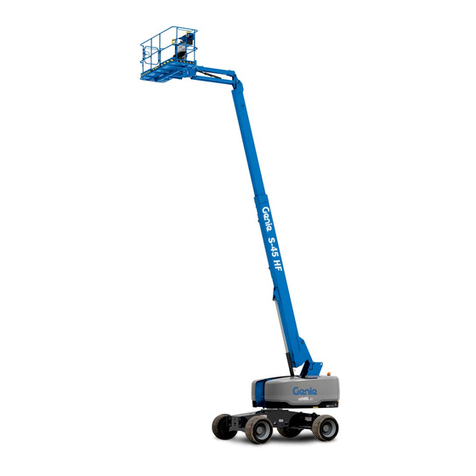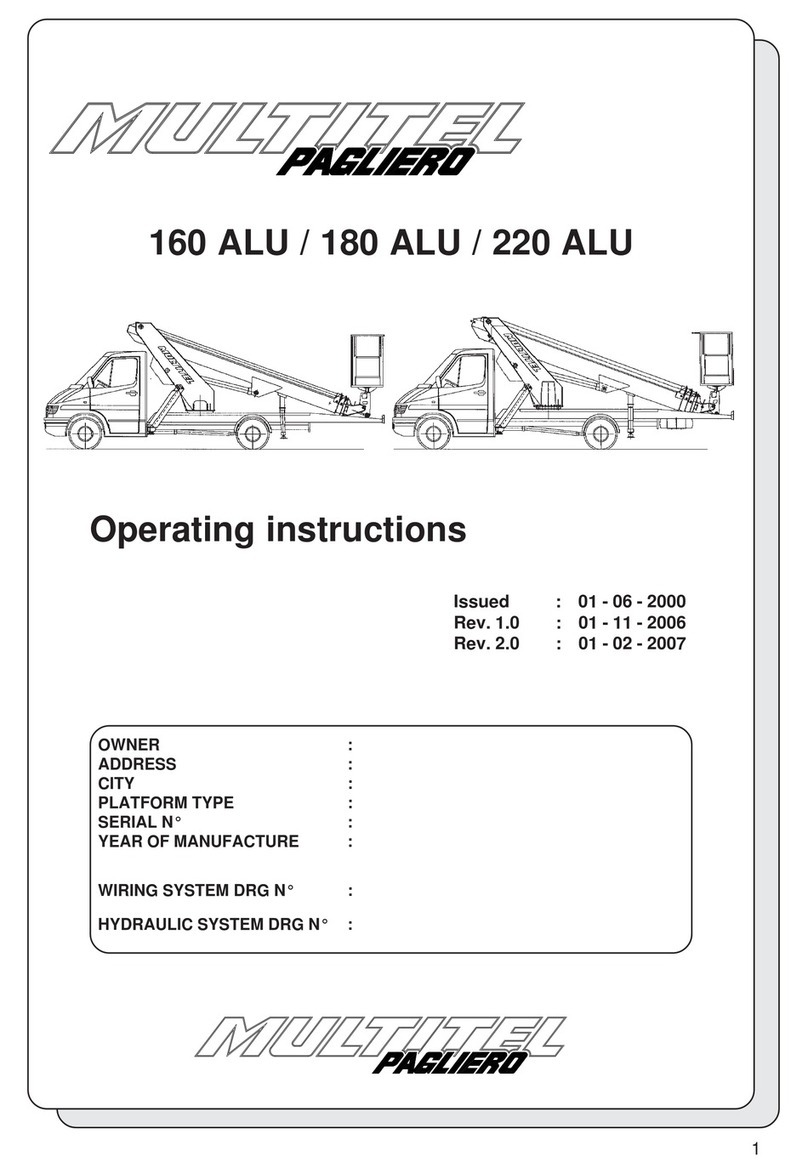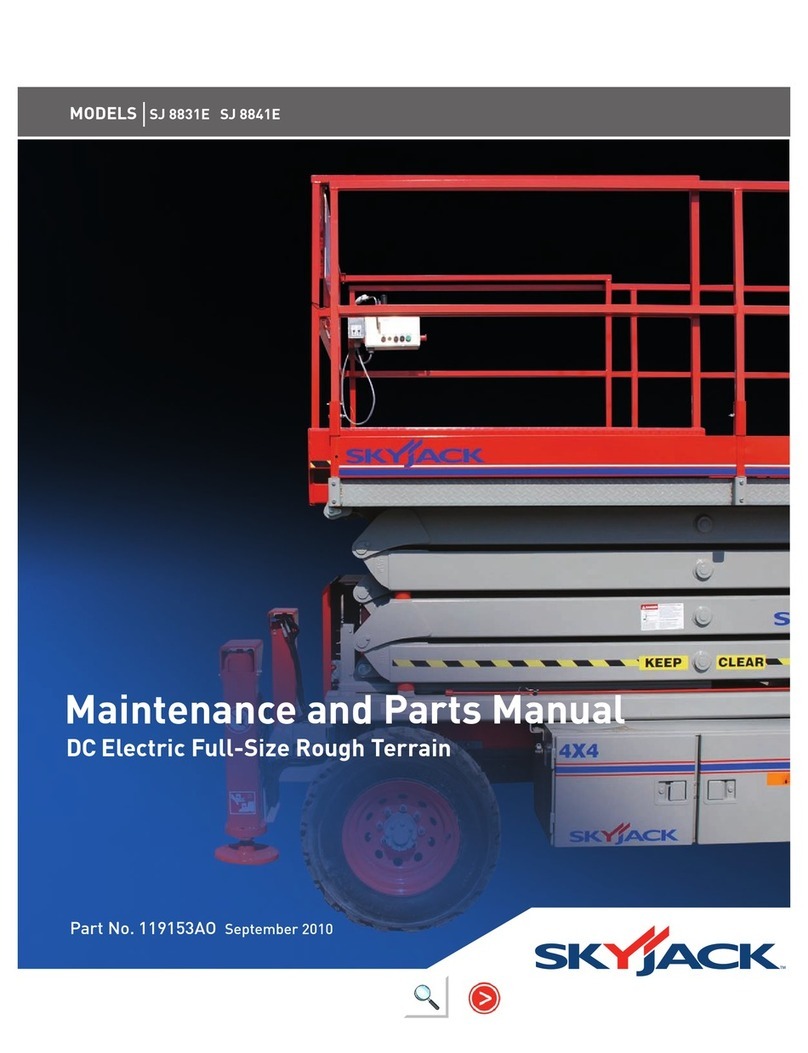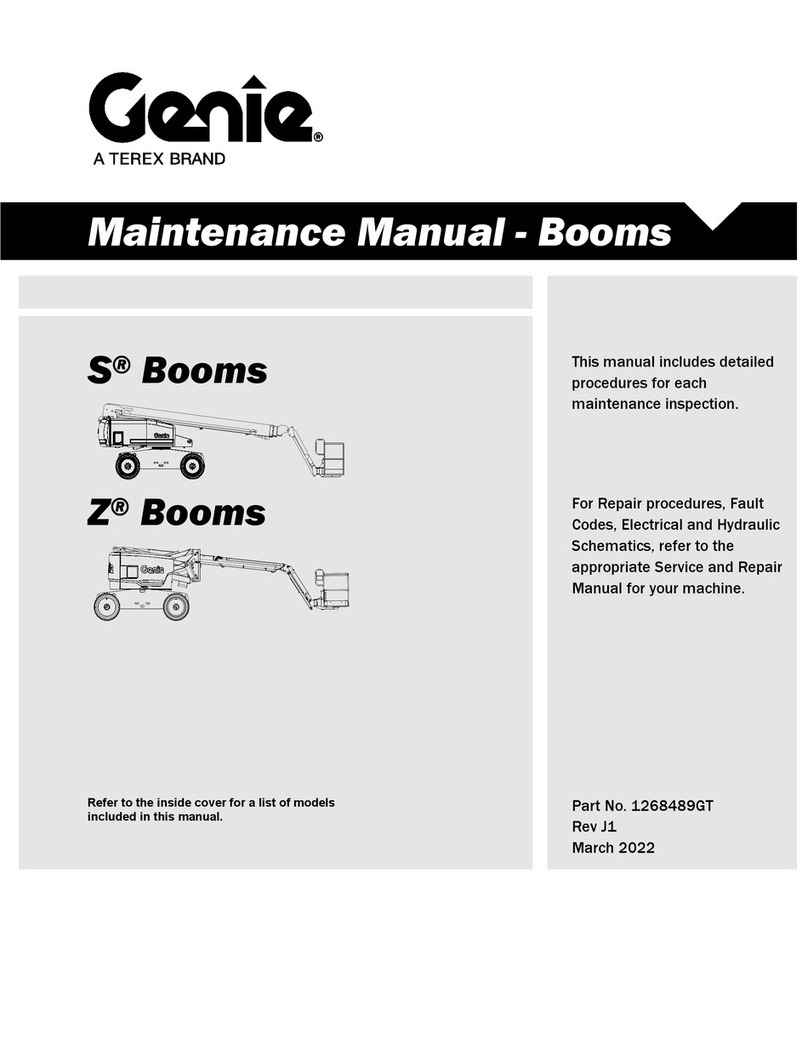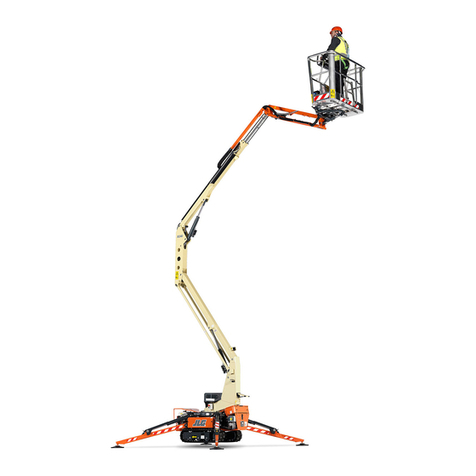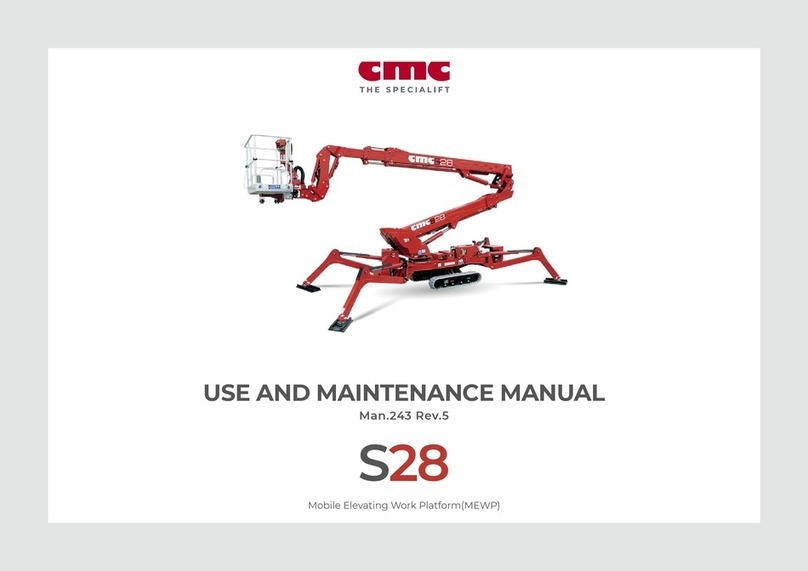Manitou MAN'GO 12 User manual

647533 EN (09/10/2015)
MAN' GO 12
MANITOU BF
BP 10249
44158 ANCENIS CEDEX - FRANCE
TEL: + 33 (0)2 40 09 10 11
YOUR DEALER
OPERATOR’S MANUAL
(ORIGINAL INSTRUCTIONS MANUAL)

647533 (09/10/2015)
MAN'GO 12

IMPORTANT
Carefully read and understand this instruction manual before using the lifting platform.
It contains all information relating to operation, handling and lifting platform equipment,
as well as important recommendations to be followed.
This document also contains precautions for use, as well as information on the servicing and routine maintenance required
to ensure the lift truck's continued safety of use and reliability.
WHENEVER YOU SEE THIS SYMBOL IT MEANS:
t
IMPORTANT
t
WARNING ! BE CAREFUL ! YOUR SAFETY OR THE SAFETY OF THE LIFTING PLATFORM IS AT RISK.
- This manual has been produced on the basis of the equipment list and the technical characteristics
given at the time of its design.
- The level of equipment of the lifting platform depends on the options chosen and the country of sale.
- According to the lifting platform options and the date of sale, certain items of equipment/functions
described herein may not be available.
- Descriptions and figures are non binding.
- MANITOU reserves the right to change its models and their equipment without being required to
update this manual.
- The MANITOU network, consisting exclusively of qualified professionals, is at your disposal to answer
all your questions.
- This manual is an integral part of the lifting platform.
- It is to be kept in its storage space at all times for ease of reference.
- Hand this manual to the new owner if the lift truck is resold.
THE TEXTS AND ILLUSTRATIONS IN THIS DOCUMENT MUST NOT BE REPRODUCED EITHER WHOLLY OR IN PART.
03/06/2015
09/10/2015
1st DATE OF ISSUE
Update
647533 (09/10/2015)
MAN'GO 12

1 - OPERATING AND SAFETY INSTRUCTIONS
2 - DESCRIPTION
3 - MAINTENANCE
647533 (09/10/2015)
MAN'GO 12

1 - 1
1 - OPERATING
AND SAFETY
INSTRUCTIONS
647533 (09/10/2015)
MAN'GO 12

1 - 2
TABLE OF CONTENTS
1 - OPERATING AND SAFETY INSTRUCTIONS
INSTRUCTIONS TO THE COMPANY MANAGER
4
PREAMBLE 4
THE SITE 4
THE OPERATOR 4
THE PLATFORM 4
THE INSTRUCTIONS 5
THE MAINTENANCE 5
INSTRUCTIONS FOR THE OPERATOR
6
PREAMBLE 6
GENERAL INSTRUCTIONS 6
A - OPERATOR'S MANUAL . . . . . . . . . . . . . . . . . . . . . . . . . . . . . . . . . . . . . . . . . . . . . . . . . . . . . . . . . 6
B - AUTHORISATION FOR USE IN FRANCE . . . . . . . . . . . . . . . . . . . . . . . . . . . . . . . . . . . . . . . . . . . . . . . 6
C - MAINTENANCE . . . . . . . . . . . . . . . . . . . . . . . . . . . . . . . . . . . . . . . . . . . . . . . . . . . . . . . . . . . . . . 6
D - MODIFICATION THE PLATFORM . . . . . . . . . . . . . . . . . . . . . . . . . . . . . . . . . . . . . . . . . . . . . . . . . . . 6
E - IC PLATFORM AXLES. . . . . . . . . . . . . . . . . . . . . . . . . . . . . . . . . . . . . . . . . . . . . . . . . . . . . . . . . . . 7
DRIVING INSTRUCTIONS 7
A - BEFORE STARTING THE PLATFORM . . . . . . . . . . . . . . . . . . . . . . . . . . . . . . . . . . . . . . . . . . . . . . . . . 7
B - DRIVER'S OPERATING INSTRUCTIONS . . . . . . . . . . . . . . . . . . . . . . . . . . . . . . . . . . . . . . . . . . . . . . . 7
C - ENVIRONMENT . . . . . . . . . . . . . . . . . . . . . . . . . . . . . . . . . . . . . . . . . . . . . . . . . . . . . . . . . . . . . . 8
D - VISIBILITY . . . . . . . . . . . . . . . . . . . . . . . . . . . . . . . . . . . . . . . . . . . . . . . . . . . . . . . . . . . . . . . . 10
E - STARTING THE PLATFORM . . . . . . . . . . . . . . . . . . . . . . . . . . . . . . . . . . . . . . . . . . . . . . . . . . . . . . 10
F - DRIVING THE PLATFORM . . . . . . . . . . . . . . . . . . . . . . . . . . . . . . . . . . . . . . . . . . . . . . . . . . . . . . . 11
G - STOPPING THE PLATFORM. . . . . . . . . . . . . . . . . . . . . . . . . . . . . . . . . . . . . . . . . . . . . . . . . . . . . . 11
INSTRUCTIONS FOR WELDING AND BLOW TORCH WORK ON THE EXTERNAL STRUCTURE 12
A - WITH ELECTRIC WELDING EQUIPMENT . . . . . . . . . . . . . . . . . . . . . . . . . . . . . . . . . . . . . . . . . . . . . . 12
B - WITH A BLOW TORCH . . . . . . . . . . . . . . . . . . . . . . . . . . . . . . . . . . . . . . . . . . . . . . . . . . . . . . . . . 12
PLATFORM MAINTENANCE INSTRUCTIONS
14
GENERAL INSTRUCTIONS 14
MAINTENANCE 14
LUBRICANT AND FUEL LEVELS 14
LEVEL OF ELECTROLYTE IN THE BATTERY 14
HYDRAULIC 14
ELECTRICITY 14
WELDING ON THE ACCESS PLATFORM 15
WASHING THE PLATFORM 15
IF THE PLATFORM IS NOT TO BE USED FOR A LONG TIME
16
INTRODUCTION 16
PREPARING THE PLATFORM 16
PROTECTING THE I.C. ENGINE 16
CHARGING THE BATTERIES 16
PROTECTING THE PLATFORM 16
BRINGING THE PLATFORM BACK INTO SERVICE 17
647533 (09/10/2015)
MAN'GO 12

1 - 3
SCRAPPING THE PLATFORM
18
RECYCLING OF MATERIALS 18
METALS. . . . . . . . . . . . . . . . . . . . . . . . . . . . . . . . . . . . . . . . . . . . . . . . . . . . . . . . . . . . . . . . . . . . 18
PLASTICS. . . . . . . . . . . . . . . . . . . . . . . . . . . . . . . . . . . . . . . . . . . . . . . . . . . . . . . . . . . . . . . . . . . 18
RUBBER. . . . . . . . . . . . . . . . . . . . . . . . . . . . . . . . . . . . . . . . . . . . . . . . . . . . . . . . . . . . . . . . . . . . 18
GLASS. . . . . . . . . . . . . . . . . . . . . . . . . . . . . . . . . . . . . . . . . . . . . . . . . . . . . . . . . . . . . . . . . . . . . 18
ENVIRONMENTAL PROTECTION 18
WORN OR DAMAGED PARTS . . . . . . . . . . . . . . . . . . . . . . . . . . . . . . . . . . . . . . . . . . . . . . . . . . . . . . 18
USED OIL. . . . . . . . . . . . . . . . . . . . . . . . . . . . . . . . . . . . . . . . . . . . . . . . . . . . . . . . . . . . . . . . . . . 18
USED BATTERIES . . . . . . . . . . . . . . . . . . . . . . . . . . . . . . . . . . . . . . . . . . . . . . . . . . . . . . . . . . . . . . 18
647533 (09/10/2015)
MAN'GO 12

1 - 4
INSTRUCTIONS TO THE COMPANY MANAGER
PREAMBLE
t
IMPORTANT
t
Whenever you see this symbol it means :
Warning ! Be careful ! Your safety or the safety of the platform is at risk.
THE SITE
Good personal control of the lifting platform’s operating area reduces the risk of accidents:
• The floor must not be unnecessarily broken or cluttered,
• No excessive slopes,
• Controlled pedestrian traffic, etc.
THE OPERATOR
Only qualified, authorized personnel can use the platform. This authorization is given in writing by the appropriate person in
the establishment with respect to the use of platform and must be carried permanently by the operator.
t
IMPORTANT
t
On the basis of experience, there are a number of possible situations in which operating the platform is contra-indicated. Such foreseeable abnormal uses, the main ones
being listed below, are strictly forbidden.
The foreseeable abnormal behaviour resulting from ordinary neglect, but does not result from any wish to put the machinery to any improper use.
The reflex reactions of a person in the event of a malfunction, incident, fault, etc. during operation of the platform.
Behaviour resulting from application of the “principle of least action” when performing a task.
For certain machines, the foreseeable behaviour of such persons as : apprentices, teenagers, handicapped persons, trainees tempted to drive a platform, operator
tempted to operate a truck to win a bet, in competition or for their own personal experience.
The person in charge of the equipment must take these criteria into account when assessing whether or not a person will make a suitable driver.
t
IMPORTANT
t
OBTAIN INFORMATION ON :
How to behave when there is a fire.
The location of the nearest first aid kit and fire extinguisher.
The emergency telephone numbers for calling (the doctors, ambulance, hospital and fire brigade).
THE PLATFORM
The platform’s suitability for us
MANITOU has ensured that this platform is suitable for use under the standard operating conditions defined in this operator’s
manual, with an overload test coefficient of 1,25 and an operational test coefficient of 1,1, as stipulated in standardised norm
EN 280 for MPLPs (Mobile Personnel Lifting Platforms).
Before commissioning, the company manager must make sure that the platform is appropriate for the work to be done, and
perform certain tests (in accordance with current legislation).
Adaptating the platform to the usual environmental conditions
- In addition to series equipment mounted on your platform, many options are available, such as : flashing light, working
headlight, etc. Contact your dealer.
- Take into account climatic and atmospheric conditions of the site of utilisation.
• Protection against frost (see chapter 3 - MAINTENANCE, LUBRICANTS page).
• Adaptation of lubricants (ask your dealer for information).
• I.C. engine filtration (see chapter 3 - MAINTENANCE, FILTER ELEMENTS page).
- The machines designed by MANITOU are designed to be used in the following temperature range:
• Minimum temperature: -15°C
• Maximum temperature: +35°C
- Special features are available, as an option, for particularly cold environments.
647533 (09/10/2015)
MAN'GO 12

1 - 5
t
IMPORTANT
t
For operation under average climatic conditions, i.e. : between -15 °C and + 35 °C, correct levels of lubricants in all the circuits are checked in production. For operation
under more severe climatic conditions, before starting up, it is necessary to drain all the circuits, then ensure correct levels of lubricants using lubricants properly suited to
the relevant ambient temperatures. It is the same for the cooling liquid.
- A platform operating in an area without fire extinguishing equipment must be equipped with an individual extinguisher.
There are solutions, consult your dealer.
t
IMPORTANT
t
Your platform is designed for outdoor use (see chapter: 2 - DESCRIPTION, CHARACTERISTICS pages) under normal atmospheric conditions and indoor use in suitably
aerated and ventilated premises. It is prohibited to use the platform in areas where there is a risk of fire or which are potentially explosive (e.g. Refineries, fuel or gas
depots, stores of inflammable products…). For use in these areas, specific equipment is available (ask your dealer for information).
Modifying the platform
- For your safety and that of others, you must not change the structure and settings of the various components used in your
platform (hydraulic pressure, calibrating limiters, I.C. engine speed, addition of extra equipment, addition of counterweight,
unapproved attachments, alarm systems, etc.) yourself. In this event, the manufacturer cannot be held responsible.
- Your lifting platform is delivered with standard wheels or all-terrain wheels. It is FORBIDDEN to switch from one type of
wheels to another: RISK OF THE LIFTING PLATFORM BECOMING UNSTABLE.
THE INSTRUCTIONS
- The operator’s manual must always be in good condition and kept in the place provided on the platform and in the
language used by the operator.
- You must necessarily replace the instructions manual, as well as any plates or stickers, if they are no longer legible or are
missing or damaged.
THE MAINTENANCE
- Maintenance or repairs other than those detailed in the chapter 3 - MAINTENANCE must be carried out by qualified
personnel (consult your dealer) and under the necessary safety conditions to maintain the health of the operator and
any third party.
t
IMPORTANT
t
Your patform must be inspected periodically to ensure that it remains in compliance. The frequency of this inspection is defined by current legislation in the country in
which the platform is use
- Example for France : The manager of the compagny using the platform must set up a maintenance book for each machine
and keep up-to-date (Ministerial Order of 2nd March 2004).
647533 (09/10/2015)
MAN'GO 12

1 - 6
INSTRUCTIONS FOR THE OPERATOR
PREAMBLE
t
IMPORTANT
t
The risk of accident while using, servicing or repairing your lifting platform can be restricted if you follow the safety instructions and safety measures detailed in these
instruction.
Failure to respect the safety and operating instructions, or the instructions for repairing or servicing your lifting platform may lead to serious, even fatal accident.
- Only the operations and manœuvres described in these operator’s manual must be performed. The manufacturer cannot
predict all possible risky situations. Consequently, the safety instructions given in the operator’s manual and on the
platform itself are not exhaustive.
- At any time, as an operator, you must envisage, within reason, the possible risk to yourself, to others or to the platform
itself when you use it.
GENERAL INSTRUCTIONS
A - OPERATOR'S MANUAL
- Carefully read and understand the operator’s manual.
- The operator’s manual must always be kept in the place provided for it on the platform and be written in the language
used by the operator.
- Any operations or manoeuvres not described in the operator’s manual must necessarily be forbidden right from the start.
- Follow the safety advice and the instructions on the platform.
- Ypu must necessarily replace the operator’s manual, as well as any plates or stickers, if they are no longer legible or are
damaged.
- A second operator must necessaily be present on the ground as a safety measure when using the platform.
- Familiarise yourself with the platform on the terrain it has to travel over.
- The machine must also be used in accordance with good engineering practice.
- Do not use the platform if the wind speed is over 45 km/h. The platform’s arms must not be subjected to a lateral force
of more than 40 kg (platforms for indoor use must not be used outside the building).
B - AUTHORISATION FOR USE IN FRANCE
(or see current legislation in other countries).
- Only qualified, authorized personnel may use the platform. This authorization is given in writing by the appropriate
person in the company, in charge of using the platform, and must be permanently carried by the operator.
- The operator is not competent to authorise the driving of the platform by another person.
C - MAINTENANCE
- The operator must immediately advise his superior if his platform is not in good working order or does not comply with
the safety notice.
- The operator is prohibited from carrying out any repairs or adjustments himself, unless he has been trained for this
purpose. He must keep the platform properly cleaned if this is among his responsibilities.
- The operator must carry out daily maintenance (see chapter : 3 - MAINTENANCE, A - DAILY pages).
- The operator must ensure tyres are adapted to the nature of the ground (see area of the contact surface of the tyres in
the chapter : 2 - DESCRIPTION : CHARACTERISTICS pages). There are optional solutions, consult your dealer.
t
IMPORTANT
t
Do not use the platform if the tyres are damaged or excessively worn, because this could put your own safety or that of others at risk, or cause damage to the platform
itself.
t
IMPORTANT
t
In the case of electric platforms, the operator must ensure that:
- The batteries are not replaced with lighter ones (compromising stability).
- Safety goggles are always worn when charging the batteries.
- The batteries are not charged in an explosive environment.
- There is no smoking and no naked flame directed towards the batteries when they are being handled during removal, re-installation and checking the levels.
D - MODIFICATION THE PLATFORM
- For your safety and that of others, you must not change the structure and settings of the various components used in
your platform yourself:
• hydraulic pressure,
• calibrating limiters,
• I.C. engine speed,
• addition of extra equipment,
647533 (09/10/2015)
MAN'GO 12

1 - 7
• addition of counterweight,
• unapproved attachments,
• alarm systems, etc...
- In this event, the manufacturer cannot be held responsible.
t
IMPORTANT
t
Your lifting platform is delivered with standard wheels or all-terrain wheels. It is FORBIDDEN to switch from one type of wheels to another: RISK OF THE LIFTING PLATFORM
BECOMING UNSTABLE.
E - IC PLATFORM AXLES
- Standard axle :
t
IMPORTANT
t
The chassis is rigid, so the platform can have a ground reach on only three wheels.
- Oscillating axle (if this option is available) :
t
IMPORTANT
t
An oscillating axle enables the platform, when in transport position, to have a ground reach on four wheels. When moving in working position over uneven terrain, the
oscillating axle is locked (the chassis is rigid) so the platform can have a ground reach on only three wheels.
DRIVING INSTRUCTIONS
A - BEFORE STARTING THE PLATFORM
- Ensure that the intermediate rail is fully in the locked position before operating the platform from the basket.
- If the platform is new, see the paragraph : before starting the platform for the first time in Chapter : 1 - safety advice and
instructions.
- Carry out daily maintenance (see chapter 3 - MAINTENANCE, A - DAILY pages).
- Before starting the platform, check the levels :
• IC PLATFORMS : • ELECTRIC PLATFORMS :
• IC engine oil • Hydraulic reservoir oil
• Hydraulic reservoir oil • Battery charge level
• Fuel
• Coolant
- The lifting platform must be in transport position (with the arms completely folded back or the scissors in the low
position) before you enter it.
- Make sure the horn works.
- Check before you use the lifting platform that the access door is properly locked.
B - DRIVER'S OPERATING INSTRUCTIONS
- Whatever his experience, the operator is advised to familiarize himself with the position and operation of all the controls
and instruments before operating the platform.
- Wear suitable clothing for driving the platform, do not wear baggy clothes.
- Make sure you have the appropriate protective equipment for the job to be done.
- Prolonged exposure to high noise levels may cause hearing problems. It is recommended to wear ear muffs to protect
against excessive noise.
- Always pay attention when using the platform. Do not listen to the radio or music using headphones or earphones
- For increased comfort, adopt the correct position in the driver’s cab.
- The operator must always be in his normal position in the driver’s seat : extending arms or legs (or, in general, any part
of the body), outside the basket is forbidden.
- Safety helmets must be worn.
- MANITOU recommends a safety harness in the operator’s size be provided when the platform is in use (for the harness
attachement in the basket , see chapter 2 - DESCRIPTION, CHECKING AND CONTROL INSTRUMENTS pages).
- The control units must never in any event be used for any other than their intended purposes (e.g. climbing onto or
down from the platform, coat-rack, etc.).
- In the case of scissors-type platforms, it is forbidden to use the platform without the guardrails in place.
- Suspending a load under the basket or on any part of the lifting apparatus is strictly forbidden.
- The operator must not climb into or get down from the basket unless it is at ground level (with the lifting system folded).
- If the nacelle is equipped with a step, the basket must be situated directly below it before mounting or dismounting.
- The platform must not be fitted with any accessory increasing the machine’s wind profile.
- Do not use a ladder or any improvised constructions in the basket to reach greater heights.
- Do not climb on the sides of the basket to reach greater heights.
- Never use the lifting platform with wet or greasy hands and shoes.
647533 (09/10/2015)
MAN'GO 12

1 - 8
C - ENVIRONMENT
- Comply with site safety regulations.
- The platform can be manoeuvred from the ground: ensure that you forbid access.
- If you have to use the platform in a dark area or at night, make sure it is equipped with working lights.
- The platforms may not be used as cranes or elevators for the permanent transport of people or materials, nor as jacks
or supports.
- When operating, ensure that there is no one or anything impeding the platform’s progress ans operation.
- When raising the platform, ensure that no one or anything inpedes the platform’s operation and do not perform any
inappropriate manœuvres.
- Do not allow anybody to come near the working area of the platform or pass beneath an elevated load. To do this, mark
your operating area with warning signs.
- Travelling on a longitudinal slope :
• Ensure that you adapt the platform’s travelling speed by controlling the speed with the travelling manipulator.
- Take into account the platform’s dimensions and its load before trying to negotiate a narrow or low passageway.
- Never move onto a loading platform without having first checked :
• That it is suitably positioned and made fast.
• That the unit to which it is connected (wagon, lorry, etc.) will not shift.
• That this platform is prescribed for the size and the total weight of the platform.
• That the slope is not greater than the platform’s maximum authorised slope.
- Never move onto a foot bridge, floor or freight lift, without being certain that they are prescribed for the weight and size
of the platform to be loaded and without having checked that they are in sound working order.
- Be careful in the area of loading bays, trenches, scaffolding, soft land and manholes.
- Ensure that the ground under the wheels and/or stabilisers is firm and stable before raising the basket.
- Do not attempt any operations outside the plarform’s capabilities.
- Ensure that the materials on the platform (pipes, cables, containers, etc ...) cannot slip off and fall. Do not heap up these
materials to the pint where you have to step over them.
t
IMPORTANT
t
If the basket must remain stationary over a structure for a long period, there is a risk that the basket will rest on this structure because of the oil cooling in the cylinders or a
minor leak in the cylinder locking system. To eliminate this risk :
- Regularly check the distance between the basket and the structure and re-adjust if necessary.
- If possible use the platform at an oil temperature as close as possible to ambient temperature.
- In the case of work near aerial lines, ensure that the safety distance is sufficient between the working area of the platform
and the aerial line.
t
IMPORTANT
t
You must consult your local electrical agency. You could be electrocuted or seriously injured if you operate or park the platform too close to power cables.
t
IMPORTANT
t
If the platform comes into contact with electric wires, press the Emergency Stop button. If you can, jump from the basket without simultaneously being in contact with the
basket and the ground.
If not, call for help, wam people not to touch the basket and to switch off the power supply to the wires or have it switched off.
- It is forbidden to use the lifting platform close to electrical power lines; observe the safety distances.
NOMINAL VOLTAGE IN VOLTS
DISTANCE ABOVE THE
GROUND OR THE FLOOR IN
METRES
50 < U < 1000 2,30 M
1000 < U < 30000 2,50 M
30000 < U < 45000 2,60 M
45000 < U < 63000 2,80 M
63000 < U < 90000 3,00 M
90000 < U < 150000 3,40 M
150000 < U < 225000 4,00 M
225000 < U < 400000 5,30 M
400000 < U < 750000 7,90 M
647533 (09/10/2015)
MAN'GO 12

1 - 9
t
IMPORTANT
t
If the wind is in excess of 45Km/h, do not perform any movements liable to endanger the lifting platform’s stability.
- To recognise this speed by eye, please refer to the empirical wind evaluation scale below:
BEAUFORT scale (wind speed at a height of 10m over flat terrain)
Degree Type of wind Speed
(knots)
Speed
(km/h)
Speed
(m/s) Ground effects Sea conditions
0 Calm
0 - 1 0 - 1 < 0,3
Smoke rises vertically. The sea is like a mirror.
1Very light
breeze
1 - 3 1 - 5 0,3 - 1,5
The smoke drift indicates the wind
direction.
Some wavelets, like fish scales, but
no foam.
2 Light breeze
4 - 6 6 - 11 1,6 - 3,3
Wind felt on exposed skin, leaves
rustle.
Small but noticeable wavelets.
3Gentle
breeze
7 - 10 12 - 19 3,4 - 5,4
Leaves and small twigs constantly
moving.
Very small waves, crests beginning
to break.
4Moderate
breeze
11 - 16 20 - 28 5,5 - 7,9
The wind raises dust and scraps of
paper, it moves small branches.
Small waves stretching, many
sheeps.
5 Fresh breeze
17 - 21 29 - 38 8 - 10,7
Small trees in leaf start to sway. Wavelets form on stretches of water,
moderate waves of some length.
6Strong
breeze
22 - 27 39 - 49 10,8 - 13,8
Large branches are moved, overhead
wires whistle, umbrella use becomes
difficult.
Waves form with white foam crests
and airborne spray.
7 High wind
28 - 33 50 - 61 13,9 - 17,1
Whole trees are moving, effort
required to walk against the wind.
The sea heaps up; some foam from
breaking waves is blown into streaks
in the wind direction.
8 Gale
34 - 40 62 - 74 17,2 - 20,7
The wind breaks off twigs, walking
against the wind is very difficult.
Moderate height longer waves with
breaking crests forming spindrift.
9 Strong gale
41 - 47 75 - 88 20,8 - 24,4
The wind damages roofs (chimneys,
tiles, etc.).
Large waves, dense spindrift
wrenched from the waves, airborne
spray reducing visibility.
10 Storm
48 - 55 89 - 102 24,5 - 28,4
Rarely seen on land, trees uprooted,
dwellings incur significant damage.
Very large waves, foam forming large
amounts of airborne spray, reducing
visibility.
11 Violent
storm
56 - 63 103 - 117 28,5 - 32,6
Very rare, extensive damage. Waves of exceptional height capable
of sinking medium-sized ships,
reduced visibility.
12 Hurricane
64 + 118 + 32,7 +
Disastrous damage. Sea completely white, air full of spray
and foam, severely reduced visibility.
647533 (09/10/2015)
MAN'GO 12

1 - 10
D - VISIBILITY
- Maintain permanently good visibility throughout the route. To increase your visibility, you can move forwards with the
pendular arm slightly raised (pay attention to the risk of falls in the basket from knocking into a low doorway, overhead
electric wires, travelling cranes, highway bridges, tracks or any obstacle in the area in front of the platform). In reverse,
look directly behind you. In any case, avoid reversing over long distances.
- If visibility of your road is inadequate, ask someone to help, standing outside the area in which the platform will be
moving, and make sure you always have a good view of this person.
E - STARTING THE PLATFORM
• PLATFORMS WITH IC ENGINES
SAFETY NOTICE
- Do not pull or push the lifting platform to start it. This type of manoeuvre would cause severe damage to the transmission. In
cases of necessity, towing requires that the lifting platform be placed in freewheeling mode (See chapter 3 - MAINTENANCE).
- If using an emergency battery for start-up, use a battery with the same characteristics and respect battery polarity when
connecting it. Connect at first the positive terminals before the negative terminals.
t
IMPORTANT
t
Failure to respect polarity between batteries can cause serious damage to the electrical circuit. The electrolyte in the battery may produce an explosive gas. Avoid flames
and generation of sparks close to the batteries.
Never disconnect a battery while it is charging.
INSTRUCTIONS
- Check the closing and locking of the hood(s).
- Turn the ignition key to notch I to switch on the electrical power, which automatically starts the pre-heating system (all
the bars must be displayed), the message“OK” is displayed.
- Check that everything is operating correctly by ensuring that no fault pages are displayed on the screen and no warning
about the fuel level
- (a pump icon is present on the screen)
- (see chapter 2 - DESCRIPTION, CHECKING AND CONTROL INSTRUMENTS pages).
- To start, turn the ignition switch to position I.
- Press the starter button.
- Do not engage the starter motor for more than 15 seconds and carry out the preheating for 10 seconds between
unsuccessful attempts.
- Check all control instruments when the I.C. engine is warm and at regular intervals during use, so as to quickly detect
any faults and to be able to correct them without any delay.
- If any faults are displayed on the screen, stop the engine and immediately take the necessary measures.
• ELECTRIC PLATFORMS
SAFETY NOTICE
- Do not use the platform if the battery is discharged to the point that movements are slowed down. In certain cases,
the platform may stop (see chapter 3 - MAINTENANCE : EVERY DAY OR EVERY 10 HOURS FOR OPERATION pages, for the
minimum permissible charge level).
INSTRUCTIONS
- Set the battery cut-out to the ON position.
- Check the closing and locking of the hood(s).
- Turn the ignition key to the basket position.
- Check that everything is operating correctly by ensuring that no error messages are displayed on the screen and that the
machine maintenance light is not flashing (see chapter 2 - DESCRIPTION, CHECKING AND CONTROL INSTRUMENTS pages).
NB: For machines not fitted with a display or a maintenance warning light, faults can be identified from the light directly
on the variable speed drive unit (to access: open the cowl on the control size, remove the casing from the variable speed
drive and see whether the light is flashing).
- If any error messages are constantly displayed or the machine maintenance light is flashing, return the key to the neutral
position.
- Set the battery cut-off to the OFFposition.
- Immediately take the necessary measures.
647533 (09/10/2015)
MAN'GO 12

1 - 11
F - DRIVING THE PLATFORM
SAFETY NOTICE
t
IMPORTANT
t
Operators should be aware of the risks connected with using the platform, notably:
- Risk of losing control.
- Risk of losing lateral and frontal stability of the platform.
The operator must remain in control of the platform.
- Do not carry out operations which exceed the capacities of your platform.
- Familiarise yourself with the platform on the terrain where it will be used.
- Ensure that the brakes work efficiently when stopping a travelling movement, taking into account the braking distances.
- Drive smoothly at an appropriate speed for the operating conditions (land configuration, load in the basket).
- Take extreme care if manoeuvring the platform with the basket in the high position. Ensure you have adequate visibility.
- Take bends slowly.
- In all circumstances make sure you are in control of your speed.
- Travel slowly on damp, slippery or uneven terrain or on truck ramps.
- Always remember that the hydraulic form of steering is very sensitive to movements.
- Never leave the I.C. engine on when the platform is unattended.
- Look where you are going and always make sure you have good visibility along the route.
- Drive round obstacles.
- Never drive on the edge of a ditch or steep slope.
- Whatever your travelling speed, you must reduce the speed as much as possible before stopping.
- The lifting platform must work in an obstacle-free area, where there is no danger descending to the ground.
- The operator using the lifting platform must be assisted by an appropriately instructed person on the ground.
- Comply with the limits shown on the lifting platform’s load graph.
INSTRUCTIONS
- When moving the platform a long distance, always travel with the arms folded or the scissors in the low position.
- Engage the appropriate gear (see chapter 2 - DESCRIPTION, CHECKING AND CONTROL INSTRUMENTS pages).
G - STOPPING THE PLATFORM
SAFETY NOTICE
- Never leave the ignition key in the platform during the operator’s absence.
- Make sure that the platform is not stopped in any position that will interfere with the traffic flow and at less than one
meter from the track of a railway.
- In the event of prolonged parking on a site, protect the platform from bad weather, particularly from frost (check the
level of antifreeze), close and lock all the platform accesses (cowls…).
- Park the lifting platform on a flat surface or on a slight slope of less than 10%.
INSTRUCTIONS
• PLATFORMS WITH IC ENGINES
- Before stopping the platform after a long working period, leave the I.C. engine idling for a few moments, to allow the
coolant liquid and oil to lower the temperature of the I.C. engine and transmission.
t
IMPORTANT
t
Do not forget this precaution, in the event of frequent stops or warm stalling of the I.C. engine, or else the temperature of certain parts will rise significantly due to the
stopping of the cooling system, with the risk of badly damaging such parts.
- Stop the I.C. engine with the ignition switch.
- Remove the ignition key.
- Check that all the accesses on the platform are closed and locked (cowls…).
• ELECTRIC PLATFORMS
- - Remove the ground/platform control selection key.
- - Check that all the accesses on the platform are closed and locked (cowls…).
- - Set the battery cut-out to the OFF position (ELECTRIC PLATFORM).
647533 (09/10/2015)
MAN'GO 12

1 - 12
INSTRUCTIONS FOR WELDING AND BLOW TORCH WORK ON THE EXTERNAL STRUCTURE
t
IMPORTANT
t
Ensure that there are no hydraulic or electrolyte leaks on the platform.
t
IMPORTANT
t
When welding, work in the opposite direction from the control console to avoid sparks damaging it.
Any welding and cutting (blow torch) work from the basket on a building’s metallic structures requires the following precautions
to be taken:
A - WITH ELECTRIC WELDING EQUIPMENT
- It is essential that the machine has a discharge braid connecting the platform’s chassis to the ground.
- It is also essential that the external structure to be welded is connected to the earth. If the above conditions are observed,
the platform can, in this case, be in contact with the structure or the elements to be welded without damaging the
electronic components.
- The power supply to the welding equipment must be via an earthed socked and any extension required just also be earthed.
- In all cases, ensure that there are no electrical arcs in the basket or on the platform (contact between the brazing rod or
the torch and the welding equipment’s earth). To ensure this, at any time the welding equipment’s earth must not be
positioned on the platform’s basket but instead only as close as possible to the element to be welded.
- Switch off the welding equipment before disconnecting the earth clamp from the element or elements to be welded.
B - WITH A BLOW TORCH
- Attach the blow torch’s bottles to the basket’s handrails.
- instructions for welding and blow torch work on the external structure
- Do not set the blow torch down on the lip of the basket while it is still operating or point it towards the control console
or its power cables.
647533 (09/10/2015)
MAN'GO 12

1 - 13
647533 (09/10/2015)
MAN'GO 12

1 - 14
PLATFORM MAINTENANCE INSTRUCTIONS
GENERAL INSTRUCTIONS
- Ensure the area is sufficiently ventilated before starting the platform.
- Wear clothes suitable for the maintenance of the platform, avoid wearing jewellery and loose clothes. Tie and protect
your hair, if necessary.
- Stop the I.C. engine before conducting any work on the platform, remove the ignition key and disconnect the “Minus”
battery terminal.
- Set the battery cut-out to the OFF position (ELECTRIC PLATFORM).
- Read the operator’s manual carefully.
- Carry out all repairs immediately, even if the repairs concerned are minor.
- Repair all leaks immediately, even if the leak concerned is minor.
- Make sure that the disposal of process materials and of spare parts is carried out in total safety and in a ecological way.
- Be careful of the risk of burning and splashing (exhaust, radiator, I.C. engine, etc.).
MAINTENANCE
- Perform the periodic service (see : 3 - MAINTENANCE) to keep your platform in good working conditions. Failure to
perform the periodic service may cancel the contractual guarantee.
MAINTENANCE LOG
- The maintenance work performed following the recommendations in Part 3 - MAINTENANCE and the other inspection,
servicing, repair and modification work performed on the lifting platform must be recorded in a maintenance log. A note
must be made, for each operation, of the date of the work, the names of the persons or companies that have performed
them, the nature of the ’operation and, where applicable, the maintenance intervals. When components in the lifting
platform have to be replaced, the components’ references must be noted.
LUBRICANT AND FUEL LEVELS
- Use the recommended lubricants (never use contaminated lubricants).
- Do not fill the fuel tank when the I.C. engine is running.
- Only fill up the fuel tank in areas specified for this purpose.
- Do not fill the fuel tank to the maximum level.
- Do not smoke or approach the platform with a flame, when the fuel tank is open or is being filled.
LEVEL OF ELECTROLYTE IN THE BATTERY
- Check the level of the battery or batteries.
t
IMPORTANT
t
When doing this, ensure you take all the safety precautions (See : 3 - MAINTENANCE).
HYDRAULIC
- Do not fill the fuel tank to the maximum level.
- Do not smoke or approach the platform with a flame, when the fuel tank is open or is being filled.
t
IMPORTANT
t
BALANCING VALVE : It is dangerous to change the setting and remove the balancing valves or safety valves which may be fitted to your platform cylinders. These
operations must only be performed by approved personnel (consult your dealer).
t
IMPORTANT
t
Ensure that all consumables and replacement parts are disposed of safety, in an environmentally friendly manner.
t
IMPORTANT
t
The HYDRAULIC ACCUMULATORS that can be fitted on your lifting platform are pressurised components; removal of these components and their hoses can be a dangerous
operation. It should only be performed by accredited personnel (please contact your dealer).
ELECTRICITY
- Do not drop metallic items on the battery (between the “Plus”and “Minus terminals”).
- Disconnect the battery or batteries before working on the electrical circuit.
- The electrical box must only be opened by authorized personnel.
647533 (09/10/2015)
MAN'GO 12

1 - 15
WELDING ON THE ACCESS PLATFORM
- Disconnect the battery or batteries before welding on the platform.
- When carrying out electric welding work on the platform, connect the negative cable from the equipment directly to
the part being welded, so as to avoid high tension current passing through the alternator or the live ring.
- If the platform is equipped with an electronic control unit, disconnect this before starting to weld, to avoid the risk of
causing irreparable damage to electronic components.
t
IMPORTANT
t
Welding operations on the structure for maintenance or repair operations must only be performed by MANITOU-certified personnel.
WASHING THE PLATFORM
- Clean the platform or at least the area concerned before any intervention.
- Remember to close and lock all accesses to the platform (cowls…).
- When cleaning with a pressure washer, avoid the articulation joints, and the electrical components and connections.
- If necessary, protect components likely to be damaged, and in particular the electrical components (variable speed drive,
charger) and connections and the injection pump from penetration by water, steam or cleaning products.
- Dry the electrical components.
- Clean the platform of any fuel, oil or grease trace.
- Grease the shafts.
FOR ANY INTERVENTION OTHER THAN REGULAR MAINTENANCE, CONSULT YOUR DEALER.
647533 (09/10/2015)
MAN'GO 12

1 - 16
IF THE PLATFORM IS NOT TO BE USED FOR A LONG TIME
INTRODUCTION
The following recommendations are intended to prevent the platform from being damaged when it is withdrawn from service
for an extended period.
For these operations, we recommend the use of a MANITOU protective product, reference 603726.
Instructions for using the product are given on the packaging.
t
IMPORTANT
t
Procedures to follow if the lift truck is not to be used for a long time and for starting it up again afterwards must be performed by your dealership.
PREPARING THE PLATFORM
- Clean the platform thoroughly.
- Check and repair any leakage of fuel, oil, water or air.
- Replace or repair any worn or damaged parts.
- Wash the painted surfaces of the platform in clear and cold water and wipe them.
- Touch up the paintwork if necessary.
- Shut down the platform (see vacuous and in load DRIVING INSTRUCTIONS).
- Make sure the cylinder rods are all in retracted position.
- Release the pressure in the hydraulic circuits.
PROTECTING THE I.C. ENGINE
- Fill the tank with fuel (see : 3 - MAINTENANCE).
- Empty and replace the cooling liquid (see : 3 - MAINTENANCE).
- Leave the I.C. engine running at idling speed for a few minutes, then switch off.
- Replace the I.C. engine oil and oil filter (see : 3 - MAINTENANCE).
- Add the protective product to the engine oil.
- Run the I.C. engine for a short time so that the oil and cooling liquid circulate inside.
- Disconnect the battery and store it in a safe place away from the cold, after charging it to a maximum.
- Remove the injectors and spray the protective product into each cylinder for two seconds with the piston in low neutral
position.
- Turn the crankshaft once slowly and refit the injectors (see I.C. engine REPAIR MANUAL).
- Remove the intake hose from the manifold or turbocharger and spray the protective product into the manifold or
turbocharger.
- Cap the intake manifold hole with waterproof adhesive tape.
- Remove the exhaust pipe and spray the protective product into the exhaust manifold.
- Refit the exhaust pipe and block the outlet with waterproof adhesive tape.
NB : The spray time is noted on the product packaging.
- Open the filler plug, spray the protective product around the rocker arm shaft and refit the filler plug.
- Cap the fuel tank using waterproof adhesive tape.
- Remove the drive belts and store them in a safe place.
- Disconnect the engine cut-off solenoid on the injection pump and carefully insulate the connection.
CHARGING THE BATTERIES
- In the case of electric platforms, in order to preserve the batteries’life and their capacity, check them periodically and
keep the charge level constant (see : 3 - MAINTENANCE).
PROTECTING THE PLATFORM
- Protect cylinder rods which will not be retracted, from corrosion.
- Wrap the tyres.
NB : If the platform is to be stored outdoors, cover it with a waterproof tarpaulin.
647533 (09/10/2015)
MAN'GO 12
Table of contents
Other Manitou Boom Lift manuals

Manitou
Manitou 200 ATJ User manual
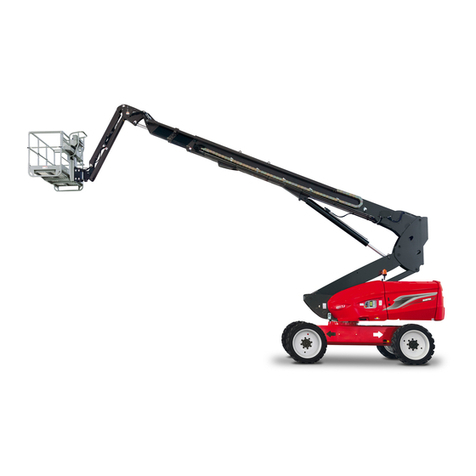
Manitou
Manitou 260 TJ User manual
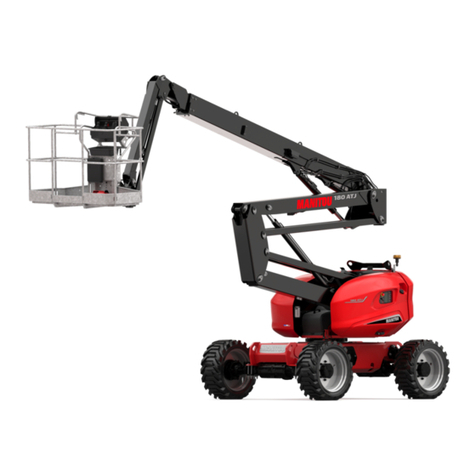
Manitou
Manitou 160 ATJ E3 User manual
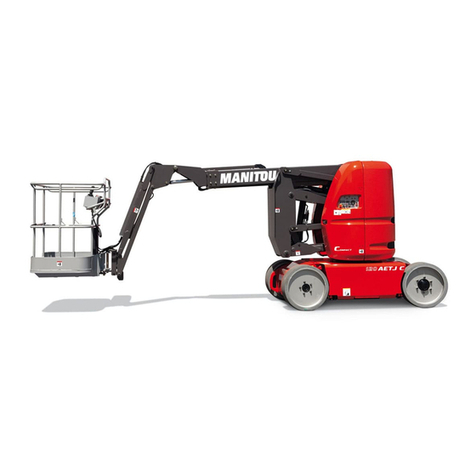
Manitou
Manitou 120 AETJ L Operating instructions
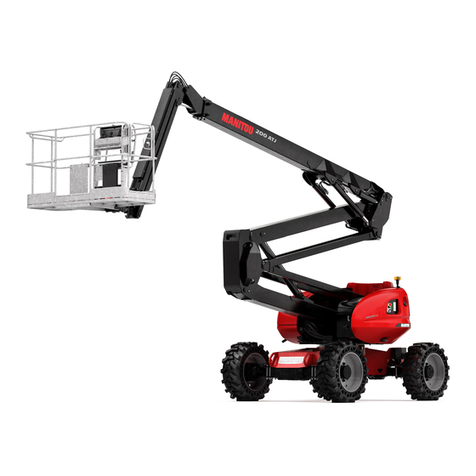
Manitou
Manitou 200 ATJ User manual
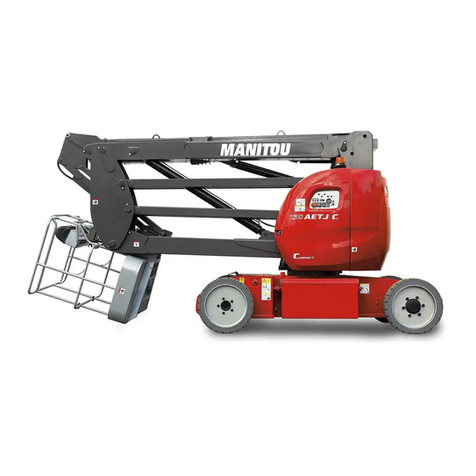
Manitou
Manitou AETJL 120 Operating instructions
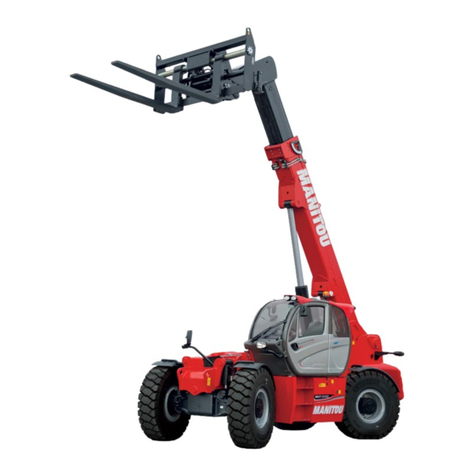
Manitou
Manitou MHT 10180 129 M ST4 S1 User manual

Manitou
Manitou 120 AETJ COMPACT User manual

